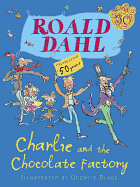
Find more great Horn Book content at these links:
Recommended books: reviews and themed booklists
App and e-book reviews
Movie reviews
Event news and recaps
Events calendar
Charlie at fifty
Veruca Salt is old enough now that she could be spoiling her own grandchildren somewhere.
 Charlie and the Chocolate Factory turns fifty this year, and publishers are taking notice. Original publisher Alfred A. Knopf commemorates the occasion with a formidably sized fiftieth anniversary edition with, as its flap copy boasts, “candy-colored pages.” The pastel interior sports Quentin Blake’s illustrations in full color, and you haven’t seen Violet Beauregarde turn into a blueberry until you’ve seen her face — and the rest of her — turn this particular shade of purply-blue. This lap-sized edition would be perfect for a cozy read-aloud; just be careful not to get chocolate all over it. (You know you’ll be eating chocolate.)
Charlie and the Chocolate Factory turns fifty this year, and publishers are taking notice. Original publisher Alfred A. Knopf commemorates the occasion with a formidably sized fiftieth anniversary edition with, as its flap copy boasts, “candy-colored pages.” The pastel interior sports Quentin Blake’s illustrations in full color, and you haven’t seen Violet Beauregarde turn into a blueberry until you’ve seen her face — and the rest of her — turn this particular shade of purply-blue. This lap-sized edition would be perfect for a cozy read-aloud; just be careful not to get chocolate all over it. (You know you’ll be eating chocolate.) Puffin celebrates with Inside Charlie’s Chocolate Factory: The Complete Story of Willy Wonka, The Golden Ticket, and Roald Dahl’s Most Famous Creation by Lucy Mangan. Though it occasionally stretches for material (history of chocolate, anyone?), this story-of-a-story gives interesting insights into the novel’s conception, publication, and later adaptations. Those familiar with Dahl’s creepy short stories for adults might not be surprised to know that Charlie was originally Charlie’s Chocolate Boy, about a boy who gets stuck in a chocolate machine, covered in chocolate, and given out as Easter candy. Theater buffs might be interested to learn that Joel Grey was seriously considered for the part of Willy Wonka in the 1971 film (and Fred Astaire wanted the part, but never asked). And any children’s lit nerd will wonder what Maurice Sendak’s illustrations would’ve looked like if he’d accepted the project; as the book speculates, “The timing suggests he was probably working on the book that would make him famous, Where the Wild Things Are.”
Puffin celebrates with Inside Charlie’s Chocolate Factory: The Complete Story of Willy Wonka, The Golden Ticket, and Roald Dahl’s Most Famous Creation by Lucy Mangan. Though it occasionally stretches for material (history of chocolate, anyone?), this story-of-a-story gives interesting insights into the novel’s conception, publication, and later adaptations. Those familiar with Dahl’s creepy short stories for adults might not be surprised to know that Charlie was originally Charlie’s Chocolate Boy, about a boy who gets stuck in a chocolate machine, covered in chocolate, and given out as Easter candy. Theater buffs might be interested to learn that Joel Grey was seriously considered for the part of Willy Wonka in the 1971 film (and Fred Astaire wanted the part, but never asked). And any children’s lit nerd will wonder what Maurice Sendak’s illustrations would’ve looked like if he’d accepted the project; as the book speculates, “The timing suggests he was probably working on the book that would make him famous, Where the Wild Things Are.”Oh, and Mangan also traces Charlie’s critical response, including a section on a 1972 article by Eleanor Cameron in a little publication called The Horn Book Magazine, condemning the book for its “overtones of sadism.”
As you may have surmised, Mangan’s book is geared toward an adult audience in its tone. It might make a good gift for the nostalgic adult in your life, whether said adult is mainly a fan of the book, the movies and other adaptations, or all of the above.
I, for one, will have “I’ve Got a Golden Ticket” stuck in my head for the next fifty years.
More on the stories behind Roald Dahl's stories here.

RECOMMENDED
ALREADY A SUBSCRIBER? LOG IN
We are currently offering this content for free. Sign up now to activate your personal profile, where you can save articles for future viewing.






Add Comment :-
Be the first reader to comment.
Comment Policy:
Comment should not be empty !!!